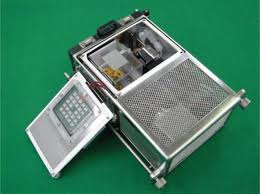Plant Experimental Unit (PEU)
Spaceflight Research Tool

- Confirmed Plants Grown:
- Key Features:
-
- LED lighting system (red and blue LEDs)
- Growth chamber where the plants grew in rockwool
- Automated watering system, delivering water directly to rockwool
- CCD camera
-
Summary
The Japanese Plant Experimental Unit (PEU) was designed for the Space Seed experiment, to test the seed-to-seed life cycle of Arabidopsis in microgravity. Eight units were launched to the ISS in 2009, and were mounted in the Cell Biology Experiment Facility (CBEF) inside the Kibo laboratory for 62 days. Arabidopsis is a very small plant, so each PEU was also quite small: the growth area of one PEU was only 4.8 cm tall, 5.6 cm wide, and 4.6 cm deep. For this experiment, there were three treatments: a ground control treatment, a simulated 1G treatment (using a turntable on the ISS), and a microgravity treatment. This experiment showed that Arabidopsis could grow and reproduce in microgravity, including processes like the formation of leaves, bolting of fluorescent stems, flowering, and seed formation.
References
- Preparation and operation of space-based experiment on plant growth in KIBO, named Space Seed (link)
- Life cycle of Arabidopsis thaliana under microgravity condition in the International Space Station Kibo module (link)
- Review and analysis of plant growth chambers and greenhouse modules for space (link)
- Review and analysis of over 40 years of space plant growth systems (link)
